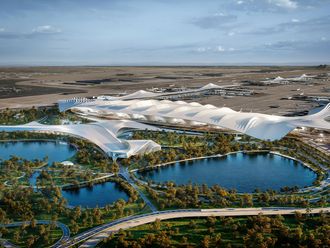
Los Angeles : By the light from a Chinatown bakery, Steve and Isela Gibbs snacked on cake at an outdoor table as the last few of the day's tourists wandered through nearby Central Plaza, under hanging red paper lanterns.
At night, the shuttered buildings adorned with Chinese symbols and crowned with graceful upward-arching roofs gave off a ghost-town feel.
"It's Saturday night, and it's dead," said Steve Gibbs, a visitor from San Diego.
Once the hub of Chinese American life in Los Angeles, the 24-block neighbourhood northeast of downtown has lost much of its lustre since its heyday in the 1940s.
During daylight hours, the Chinese-themed shops and restaurants clustered around three main plazas still draw visitors hunting for cheap souvenirs and authentic Asian cuisine.
A slew of new art galleries also draw daytime visitors. But critics say Chinatown has become a virtual dead zone after dark, despite efforts by city officials and business leaders to attract more crowds.
In the latest attempt to draw evening visitors, the city of Los Angeles plans to spend more than $3 million (Dh11 million) in public funds for facade improvements, lighting upgrades and a series of outdoor events this summer.
Skeptical about plan
But merchants and property owners who have witnessed previous efforts fail to resurrect the neighbourhood are skeptical about the plan. What's worse, they can't agree on what is needed to turn Chinatown around at night.
"Everyone is waiting for something to happen," said Richard Liu, an architect and longtime Chinatown property owner.
Some Chinatown merchants propose regularly scheduled cultural and music events, while others are calling for simple upgrades such as adding more parking or outdoor dining areas.
"Nobody has a sense of what to do," said Jenny Cho, author of "Chinatown in Los Angeles," a book that chronicles the history of the neighbourhood through historic photographs.
Chinatown's woes echo the plight of urban Chinese American inner-city neighbourhoods such as those in Houston and Honolulu, where crime and slumping business have become growing concerns.
Meanwhile, other Chinatowns, including those in San Francisco and New York, continue to thrive.
Merchants, historians and others attribute many of the changes at Los Angeles' Chinatown to several factors, including increased crime years ago, the exodus of Chinese American families to the suburbs and an influx of recent Asian immigrants more concerned with making a living than reviving Chinatown.
As a result, visitors looking for authentic Chinese food have many options beyond Chinatown, including eateries in the San Gabriel Valley, home to a growing Asian population. "Chinatown is in a state of evolution and is no longer the Chinatown of past years," said former Los Angeles City Council member Michael Woo, who now heads Cal Poly Pomona's College of Environmental Design.
Thriving beginning
The neighbourhood took root in the 1870s, between El Pueblo Plaza and Old Arcadia Street, before relocating in the 1940s to its current location to make way for what is now Union Station.
It thrived in the beginning and had a short rebirth in the 1970s when clubs such as Madam Wong's and Hong Kong Cafe booked punk and New Wave bands like the Police and Oingo Boingo.
But nighttime tourists began to abandon Chinatown in the 1980s and 1990s as crime increased, underscored by the shooting death in Chinatown of Academy Award-winning actor Haing S. Ngor in 1996.
Today, violent crime rates in the downtown area that includes Chinatown are relatively low — down 21% from 2008, according to the Los Angeles Police Department.
Still, Chinatown is caught in a vicious cycle. Merchants say Chinatown doesn't attract enough after-dark visitors to justify staying open late. But tourists won't visit Chinatown at night unless the shops stay open to serve them.
The latest Chinatown renewal project died last year when financing fell through on a $162-million apartment, retail and parking project that was planned for a vacant restaurant site on North Broadway.
The failure of the retail complex project deprives Chinatown of much-needed parking, said Chester Chong, president of the Chinese Chamber of Commerce of Los Angeles.
Under the latest revival effort, the city will add trash cans, a prominent art piece and performance space, and repair the dilapidated wishing fountain in the Central Plaza, among other improvements.
The plan gives hope to some merchants who believe that Chinatown can return to its former glory days.












